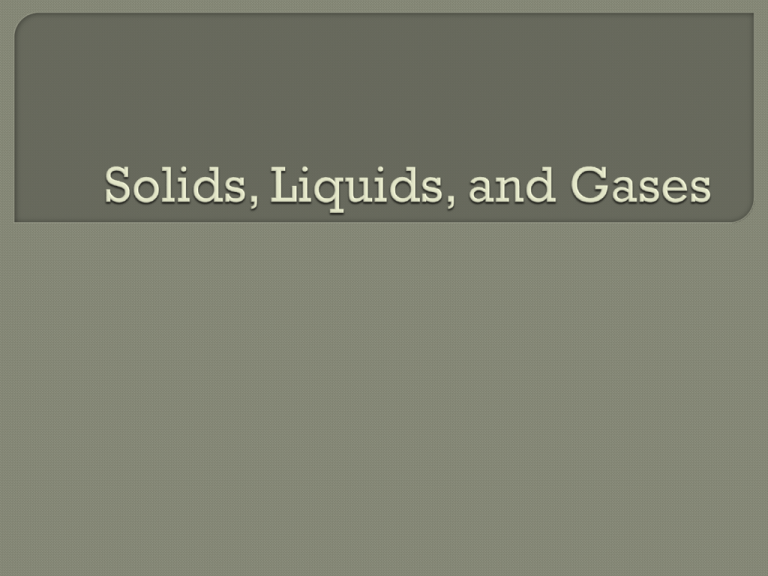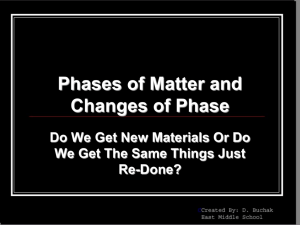Solids, Liquids, and Gases
advertisement

Copy the question and answers What state of matter is defined by definite volume but indefinite shape? • A. Solid • B. Liquid • C. Gas • D. Plasma Unit 2 Test • Let’s take a look • Any retakes? Binder checks Opener Turn Ins New binder list • Easy points • Make sure you are keeping track Take 20 minutes • Do your best • Give as much information as possible ASVAB • 1st-4th periods • You guys will still be in here Notes to help with tomorrow’s assignment Copy question and answers What state of matter has the most organized particles? • A. Solid • B. Liquid • C. Gas • D. Plasma Unit 2 Test • Retakes on Thursday after school • You must tell me you are coming Unit 3 Pre-Test • States of Matter Chart Card Game • 15 minutes Extension to the game • Try to sort all cards for solids into two categories • What are your categories? • Write a paragraph about solids using information from the cards Complete in class • If you can’t get it done, it is homework Copy question and answers What is the word that measures the amount of material of an object? • A. Volume • B. Weight • C. Density • D. Mass ASVAB • How do you think you did? Assignment • Turn in 3 players Try to collect all the cards which describe a state Each player pick one card One by one (clockwise, starting with youngest player) pick a card • If the card matches your state, keep it. If not, put it back • Winner: First player to get all 10 cards for one state Place your 10 cards into two categories • Category 1: Describes what we find by observing • Category 2: Describes how the “Particle Theory” explains observations Write a paragraph about your state • Use the cards to help you If you haven’t finished that worksheet • Finish it NOW!!!!!! • Turn it in before you leave Copy question and answers Temperature is a measure of… • A. heat • B. how hot something is • C. How cold something is • D. average kinetic energy Solids, Liquids • Card game and Gases Practice 2 players Place cards face down in a pile One by one (starting with oldest player) choose a card and put it on the board. Goal: Get Four in a row. It can be vertical, horizontal, or diagonal The Kinetic Molecular Theory explains the forces between molecules and the energy that they possess. • This theory has 3 basic assumptions. Matter is composed of small particles (molecules). The measure of space that the molecules occupy (volume) is derived from the space in between the molecules and not the space the molecules contain themselves. The molecules are in constant motion This motion is different for the 3 states of matter. • Solid - Molecules are held close to each other by their attractions of charge. They will bend and/or vibrate, but will stay in close proximity. • Liquid - Molecules will flow or glide over one another, but stay toward the bottom of the container. Motion is a bit more random than that of a solid. • Gas - Molecules are in continual straight line motion. The kinetic energy of the molecule is greater than the attractive force between them, thus they are much farther apart and move freely of each other. • When the molecules collide with each other, or with the walls of a container, there is no loss of energy. Copy question and answers What type of energy is related to storing for use later? • A. Nuclear Energy • B. Mechanical Energy • C. Radiant Energy • D. Thermal Energy Connect Four • Solids, Liquids and Gases Notes on Phases • Kinetic Molecular Theory 12 minutes • Fill in blanks • Fix any answers that are wrong Project Due Introduction next Wednesday • Plenty of time • Limited time in class to work on it • We will continue learning • Any questions? • What are your partners? • What compound? Volatile liquids‐ liquids that evaporate readily Nonvolatile liquids‐ evaporate slowly, have strong attractive forces between particles Phase diagrams‐ a graph of pressure versus temperature that shows the conditions under which the phases of a substance exist Triple point‐ indicates the temperature and pressure conditions at which the solid, liquid, and vapor of the substance can coexist at equilibrium • Critical temperature‐ the temperature above which the substance cannot exist in the liquid state • Water 373.99°C Critical pressure‐ the lowest pressure at which the substance can exist as a liquid at the critical temperature • Water 217.75 atm Freezing Point (Fusion & Crystallization Point) • Temperature at which the liquid becomes a solid Melting Point • Temperature at which the solid becomes a liquid Melting Point and Freezing Point are the SAME Temperature • Boiling Point • Temperature at which the liquid becomes a gas Normal Boiling Point is at atmospheric pressure (1 atm or 760 torr or 101.3 kPa) Condensing Point • Temperature at which the gas becomes a liquid The Boiling and Condensing Point are the SAME Temperature You should work on your project • I have given you examples in your notes • Remember it is due Wednesday • Not using class time to work on it






